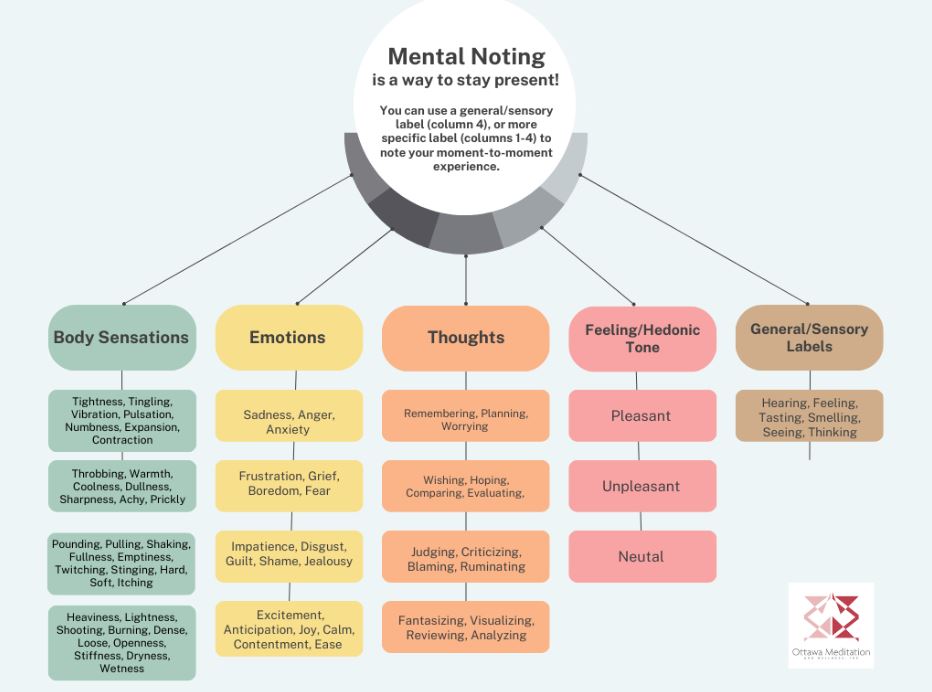
What is mental noting?
Mental noting (also called, labelling or naming) can be incorporated into our formal and informal mindfulness practice as a tool to keep awareness on track. It’s a gentle acknowledgement of our moment-to-moment experience, helping us to stay present and tease out aspects of our inner experience, whether body sensations, thoughts, or emotions.
When noting, we use one word to name what’s happening; for example, we might say: “This is anger,” “Anxiety is arising,” or “Frustration or restlessness is present.” Doing this is an opportunity to acknowledge and witness to what we are experiencing and can help us to disentangle or unstick from challenging emotions, thoughts, moods or mind states. When we do this, we usually feel some space or emotional freedom.
The mental note can be general, such as “hearing,” “thinking,” “feeling,” “seeing,” or “in/out” for the breath. It can be more specific such as:
- With Sensations, we might notice and note: “tension,” “tightness,” “contracted,” “ease,” “openness,” “heat,” “sharpness,” “racing,” “stabbing.”
- Emotions: “restlessness,” “calm,” “anxiety,” “joy,” “irritation,” “anticipation,” “sadness.”
- Thoughts: “thinking,” “judging,” “remembering,” “planning,” “criticizing,” “analyzing,” “imagining,” “rumination.”
- Feeling tone: “pleasant,” “unpleasant,” “neutral.”
I have included a word chart below to support more verbal fluency so that noting flows more easily.
Notably, noting requires a light touch; just 5% is on the label (one word), and 95% is on awareness of the experience itself. The key is not to spend too much time thinking about the “perfect note.” The most obvious note is the best one for you in the moment, so no straining is necessary. The label’s tone is also important and should be soft, almost like a whisper or a gentle nudge to encourage mindfulness so that attention is on the felt experience.
Here are some of the pros and cons of mental noting:
Pros
- it keeps us present.
- Judson Brewer points out that it can create an “observer effect” — by noting thoughts or emotions, for example, we become less identified with them.
- put another way, it helps us maintain non-reactive attention –recognizing and noting change as it occurs makes us less likely to get caught up in emotional reactions. In fact, research by David Creswell and colleagues (2007) found that when we label difficult emotions, the amygdala, the alarm bell of the brain, becomes less active and less likely to trigger a stress reaction in the body.
- other benefits that Gil Fronsdal (Insight meditation teacher) points out is that it directs thinking and gives the mind something to do rather than leaving it to its own devices – “an idle mind can get into trouble,” so mental noting can be a way to interrupt the incessant flow of discursive thinking.
- it can also help to recognize patterns in our experience (i.e., a frequently repeated “worry” note might reveal persistent worry thought patterns that may not have been seen before.)
- it may lead to “truth-telling” when we’re reluctant to admit something about ourselves or what is happening.
Cons
- it can become mechanical.
- some may get too focused on finding the perfect note rather than being mindful.
- may create an artificial distance from the experience when naming becomes a substitute for feeling.
Mental noting is an optional mindfulness tool many find helpful, while others may prefer not to use it. Mental noting isn’t fixed, so feel free to experiment and find your own way!
I love to use noting, especially for short check-ins or difficult emotions, to the extent that it has become a constant companion!
Here’s a noting practice for you to try!





